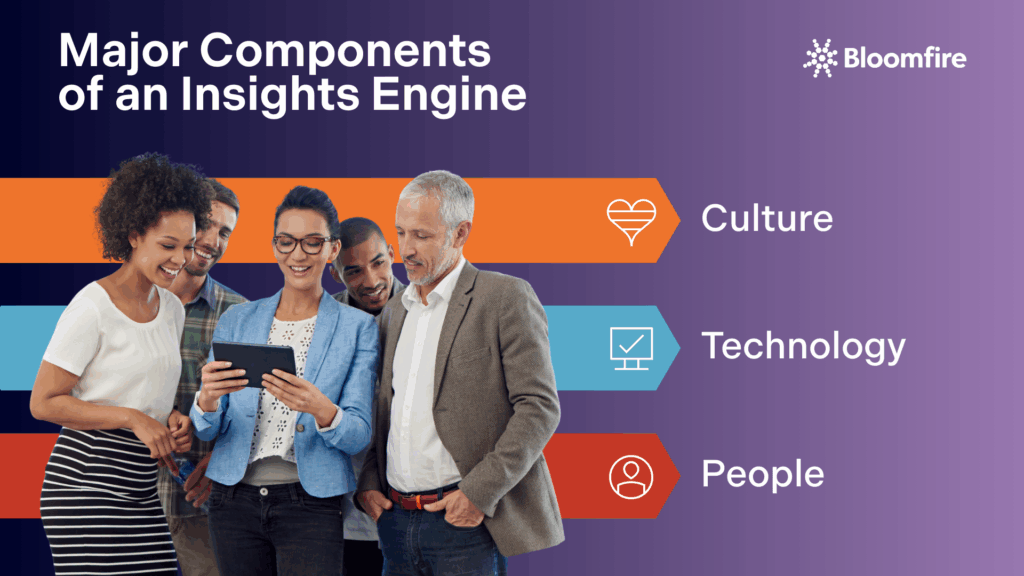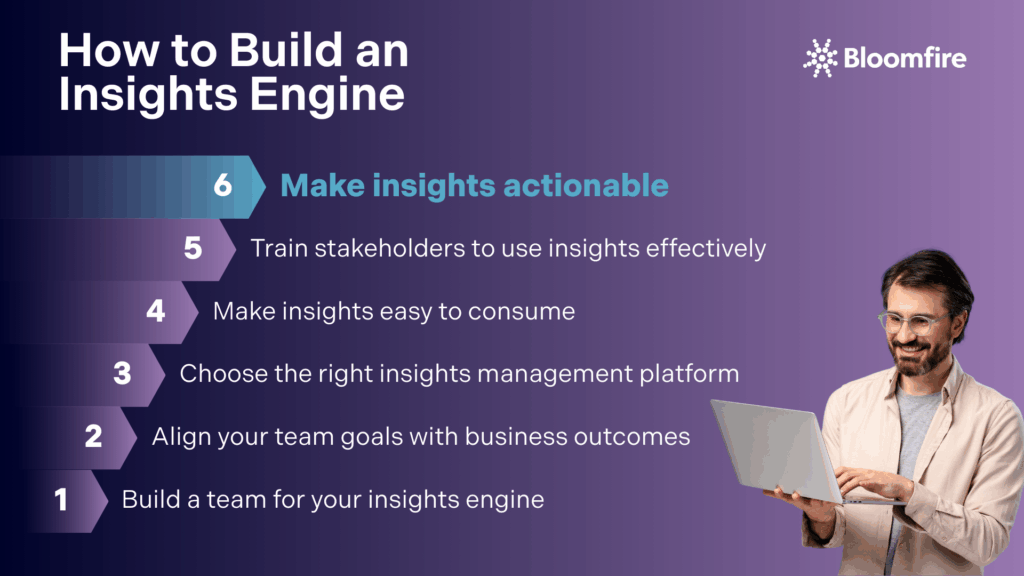How to Build an Insights Engine: The People, Technology, and Culture You Need

Enterprises have access to many data sources, research tools, and people skilled at pulling meaningful insights out of data. In this data flood, a fundamental challenge persists: how do we effectively disseminate these insights to the decision-makers who can truly benefit from them?
It’s a familiar tale in many organizations. Insights remain confined within specific teams, lost amidst the clutter of email inboxes, or buried within slide decks that senior decision-makers barely skim through. The unfortunate result? Stakeholders often make crucial decisions based on assumptions or gut feelings. However, this issue can be addressed if you have a functional insights engine in place.
Building an insights engine isn’t just about technology. It requires the right team, processes, and culture. The key steps to creating insights engines involve forming your team, aligning goals, selecting the best insights management platform, enhancing insights, training stakeholders, and keeping knowledge actionable.
What Is an Insight Engine?
An insight engine is a dynamic, AI-powered system that transforms raw data into actionable intelligence. It is embedded directly into the decision-making processes of an organization.
Going beyond traditional business intelligence tools that merely present data, a consumer insight engine leverages technologies like natural language processing (NLP) and machine learning to process data and information. They uncover hidden patterns, understand customer sentiment, and predict market trends from a wide range of structured and unstructured data sources.
The transformative nature of the insights engine, which the Harvard Business Review defines as a key driver of modern business, empowers organizations to enhance revenue, foster innovation, and deliver an exceptional customer experience by distilling complex information into strategic recommendations that lead to a clear path forward.
Why Insights Engine Matters
A startling survey revealed that in 58% of organizations, more than half of all business decisions rely on intuition and experience rather than hard data and insights. Additionally, 73% of company data goes completely unused for analytics. That’s a kind of waste organizations should be concerned about.
Despite massive investments in data collection, most organizations struggle to transform this information into actionable business decisions. An insight engine bridges this critical gap. Unlike traditional analytics that simply process information, a well-designed insight engine connects data with decision-makers, allowing verified knowledge to influence foresight and direction.
This approach also allows companies to make decisions that closely align with business goals while providing excellent customer experiences. Furthermore, organizations that centralize their insights and make data-driven decisions are eight times more likely than their less advanced peers to grow revenue by 20% or more.
Three Major Components of an Effective Insights Engine
Constructing an insights engine hinges on the combination of the right people, cutting-edge technology, and finely tuned processes. These essential elements propel customer insights to the forefront, making them accessible, visible, and actionable. Let’s dive into these critical components, illuminating the path to building a successful consumer insights engine.

Boost Your ROI with Insights
Use our ROI calculator to see estimate how much time & money your organization is losing without a knowledge management platform.
Calculate Now
1. People: The Skills and Knowledge to Deliver Impactful Insights
Your organization’s people and their knowledge are its most significant strategic advantage. An insights team with the right balance of skills to interpret data and communicate their findings is an essential component of an insights engine. Specifically, people with the following skills for insights delivery engine creation and maintenance are invaluable to your team.
a. Analytical and creative thinking
Insights teams have traditionally focused on analyzing data, so it’s no surprise that many people drawn to this field are highly analytical. But a successful insights engine requires a combination of analytical and creative thinking: people who can analyze data, uncover the insights that matter most, and present their insights and recommendations in ways that resonate with their stakeholders.
b. Understanding how insights support business goals
Insights professionals should see the forest, not just the trees. Kantar Vermeer’s Insights2020 study found that 75% of respondents from high-performing firms believed their insights teams were business-focused, compared to only 50% from lower-performing firms.
Advanced insights teams generate insights and understand the profound business impact of their work. They tailor their insights delivery to meet the diverse needs of various stakeholder groups.
c. Storytelling and marketing
For insights to have a meaningful impact on an organization, insights team members must skillfully market to their internal audience. Data analytics can be boring, considering it deals with a high volume of numbers. It is up to your team to appeal to the audience’s interest and make sense of the data.
One of the most potent strategies to captivate this audience is transforming data and insights into compelling narratives that evoke stakeholder action and engagement.
2. Technology: Increasing the Visibility and Reach of Insights
People are the foundation of a powerful insights-sharing engine. Yet an insights management platform, which is software designed to make insights accessible, searchable, and digestible, magnifies the contributions of these individuals. It encourages collaboration across functions and empowers businesses to act innovatively on insights.
a. A single source of truth
An insights management platform centralizes research and content that may have previously been scattered across multiple repositories. This consolidation ensures that insights team members and stakeholders have a singular go-to place for accessing all finalized research and can trust that the information is consistently up-to-date.
b. Search across all content types
In many organizations, the challenge isn’t a lack of data and insights; it’s the ability to surface the correct information when needed. An effective insights management platform conducts in-depth indexing of all content, making everything searchable – including spoken words within video and audio files.
c. Insights amplification
An insights team’s goal is to amplify the voice of the customer and the market, and an insights management platform acts as the megaphone that empowers them to do so–an ideal business case for this technology. Ideally, the platform should provide multiple avenues for insights teams to disseminate information to stakeholders. While the platform is the primary source for accessing insights, teams may also curate content for distribution in email newsletters or send notifications about new content via platforms like Slack or Microsoft Teams.
d. New ways for stakeholders to engage
One of the most powerful features of an insights management platform is its ability to establish direct channels of engagement between insights teams and stakeholders, fostering a dynamic feedback loop. Stakeholders can contribute comments or pose questions to gain deeper insights, while insights teams can leverage the platform’s engagement metrics to uncover knowledge gaps, explore new research questions, and identify high-impact insights.
Boost Your ROI with Insights
Use our ROI calculator to estimate how much time & money your organization is losing without a knowledge management platform.
Calculate Now
3. Culture: Embedding Insights Across the Organization
Having a data-driven culture pays off immensely. According to research from Deloitte, businesses with a robust analytics culture are twice as likely to exceed their business goals as those that are less mature. Unfortunately, only 37% of business leaders report that their organization has a strong data and analytics culture.
Establishing a mature data and analytics culture requires organizations to make sharing insights and leveraging them in decision-making the new norm. And this isn’t a one-time endeavor. Even after launching an insights engine, it’s crucial for insights team members to actively demonstrate and encourage the behaviors they want to see across the organization.
a. Make insights sharing effortless
Packaging insights for consumption can be laborious, from synthesizing data across various sources to distilling results into key takeaways that stakeholders can effortlessly digest. While this inherently involves human input, technology can significantly ease the burden. For example, adopting an insights management platform that automatically generates summaries of PDFs or other text-based documents can save team members from the tedious task of manually crafting a summary for every report.
b. Foster and encourage desired behaviors
Adapting to new routines takes time, and it’s common for some team members or stakeholders to initially revert to old habits after the launch of an insights engine. Leading by example and actively promoting the desired behaviors is vital when this occurs. For example, if a stakeholder emails a research question, respond by sharing a link to a document that answers their question in your insights management platform, or encourage them to post their query in the platform if there isn’t already a documented answer.
c. Empower stakeholders with self-serve resources on market research
In addition to sharing finalized market research reports and insights, allow your stakeholders to learn more about what you’re working on. Consider sharing educational resources on various research methodologies, data sources, and tools used by your insights function, among other relevant topics. Encourage stakeholders to ask questions in your insights management platform (and make sure your team answers them on time) so your organization’s collective intelligence continues to grow.
d. Provide ongoing training for data-driven decision-making
Deloitte’s research underscores many business decision-makers’ challenges when accessing and utilizing data. To address this, offer regular training sessions on harnessing data and insights for decision-making. With training sessions and self-serve resources, stakeholders will gain the confidence and knowledge needed to leverage your insights team’s findings effectively.
6 Key Steps to Building an Insights Engine
The value of an insights engine is rooted in its capacity to transform how organizations operate, empowering teams to make smarter decisions and respond to market changes with agility and confidence. To unlock this value, you must combine the three components of an effective insights engine mentioned above through the following steps.

1. Build a team for your insights engine
Building an insights engine team that can transform raw data into strategic action requires carefully selecting individuals with complementary skills and creating an environment where they can collaborate effectively. Beyond analytical and creative abilities, several other critical skills distinguish high-performing insights teams:
- Commercial acumen: Team members need a comprehensive understanding of how the business operates, including objectives and growth strategies
- Domain knowledge: Deep familiarity with customers, market conditions, and factors influencing company performance provides essential context for meaningful insights
- Problem-solving capabilities: The ability to navigate complex challenges, identify patterns in data, and develop innovative solutions to business problems
Insights professionals must function as internal marketers, identifying appropriate channels, timing, and messaging to deliver findings effectively to decision-makers. This is where data storytelling can set your insight engine team apart.
Keep in mind that without these storytelling skills, valuable insights may go unnoticed or forgotten by stakeholders. As Harvard Business School Professor Jan Hammond notes, “I’ve learned that it’s the soft skills that are the hardest to master, but they’re critically important.”
2. Align your team goals with business outcomes
Insights teams must transcend the traditional role of data providers to become strategic partners in business growth. This transition requires a fundamental shift from reactively responding to requests to proactively offering recommendations tied to business objectives.
To achieve this alignment, insights professionals require visibility into business goals and training on establishing research priorities based on those objectives. Some organizations have strengthened this connection by linking staff bonuses to broader business unit performance, creating shared accountability with other functions.
For optimal results, consider positioning data team members directly within business teams. This proximity drives better insights, faster pivots, and closer alignment between data work and operational needs.
3. Choose the right insights management platform
An insights management platform serves as the centralized hub that gathers, integrates, and analyzes insights from multiple sources. These platforms can reduce insight reporting time from months to days while eliminating up to 90% of associated workload.
For example, a comprehensive insights management platform like Bloomfire provides features like real-time conversation summaries, context indexing, and accelerated internal sharing through workplace app integration. These capabilities enable teams to gain more feedback in stakeholder engagements and develop a deeper understanding of their audience.
Choosing the best insights management platform for your organization requires a clear understanding of your needs and expected outcomes–all of which a Bloomfire expert can help you navigate. Book a demo for a free consultation.
4. Make insights easy to consume
Organizations that create this culture see tangible benefits—becoming 6% more productive and 5% more profitable than those that don’t.To maximize the impact of your insights engine, information must be readily digestible for all stakeholders.
Consider adapting content format based on audience needs:
- Written reports for comprehensive details
- Slide decks for visual, concise overviews
- Interactive dashboards for dynamic exploration
- Infographics for quick visual snapshots
Data visualization transforms raw numbers into compelling stories, making complex information accessible and actionable. Consequently, when communicating insights, avoid technical jargon and use concise, active sentences that clearly state key facts.
5. Train stakeholders to use insights effectively
Provide educational resources that address the fundamentals of research methodology, best applications for various project goals, and the limitations of different methods. This approach empowers stakeholders to understand not just what the data shows, but why it matters. As a result, you don’t simply encourage comprehension but action towards utilizing customer insights.
To build data literacy, tailor training to match different stakeholder groups’ needs. For example, executives need high-level business impact training, while marketing teams benefit from focusing on customer behavior metrics.
6. Make insights actionable
Insights without action create no value. The most sophisticated insight engine delivers real return on investment (ROI) only when decision-makers act on the knowledge it provides.
Strategic insights teams tailor findings for different stakeholders to maximize impact. For instance, at Lubrizol, more than 2,000 employees access their insights platform, where teams include targeted calls to action for different stakeholder groups. This makes insights immediately digestible before stakeholders dive deeper into reports.
Insights Engine and Enterprise Intelligence: How Are They Connected?
An insights engine operates as a strategic component within a larger Enterprise Intelligence framework. Enterprise Intelligence converges the discipline of knowledge management, the reach of enterprise search, and the insight of business intelligence into a transformative force.
An insights engine contributes to this ecosystem by actively orchestrating and surfacing knowledge. It analyzes large amounts of data—including customer feedback, usage data, and market research—to uncover the intents behind consumer behavior. This allows for faster, data-driven decision-making and a more proactive approach to product development. It also naturally extends towards other teams.
For example, a marketing team can use consumer and marketing insights to access real-time consumer feedback and behavioral data, which helps them pressure-test new campaign ideas and validate product messaging early in the development cycle. Instead of waiting for a quarterly report, they can instantly retrieve data on shifts in buyer behavior, ensuring their strategies are always relevant and aligned with market demands.
Frequently Asked Questions
What are insights used for?
Insights are used to drive smarter, more informed business decisions by providing a deeper understanding of trends, customer behavior, and market dynamics. They enable organizations to move from reactive to proactive strategies, fostering innovation and creating a competitive advantage.
How do you develop insights from data?
Developing insights from data is a systematic process that begins with clearly defining a business objective and gathering relevant data from various sources. It then involves analyzing that data to discover hidden patterns and translating those findings into a clear, actionable story that informs strategic decisions.
What are the critical capabilities for insight engines?
The critical capabilities for an insight engine include the ability to connect to and process various structured and unstructured data sources in real-time. It must also leverage artificial intelligence and machine learning to uncover hidden connections, provide proactive recommendations, and deliver them through an intuitive, user-friendly interface.
People, Technology, and Culture: The Essential Elements of an Insights Engine
Building an insights engine requires your organization to transition from a traditional research provider model, where insights teams reactively respond to line manager requests, to a more strategic paradigm. In this new approach, insights teams make their findings and recommendations easily accessible and actionable for organizational stakeholders.
This transformation hinges on aligning your efforts with Bloomfire’s product vision: “The Intersection of People, Knowledge, Process & Technology.” Our unified, certified knowledge platform fosters collaboration, raises every employee to the level of a top performer, and empowers you to build a data-driven culture that drives success.
Build Your Insights Engine Today!
Start creating your insights engine and process data for informed actions.
Let Our Expert Help

Enterprise AI Search: Definition, Benefits, and Evolution

The Benefit of Company-Wide Knowledge Management in 2026

Are You Making These Common Knowledge Sharing Mistakes?

Estimate the Value of Your Knowledge Assets
Use this calculator to see how enterprise intelligence can impact your bottom line. Choose areas of focus, and see tailored calculations that will give you a tangible ROI.

Take a self guided Tour
See Bloomfire in action across several potential configurations. Imagine the potential of your team when they stop searching and start finding critical knowledge.